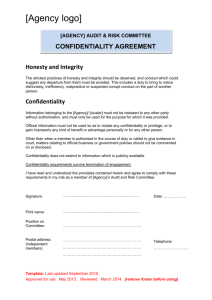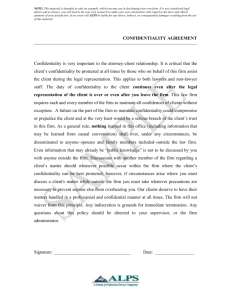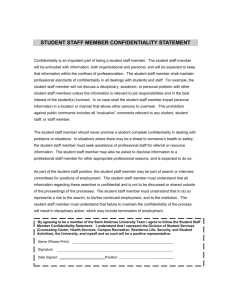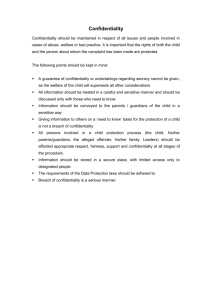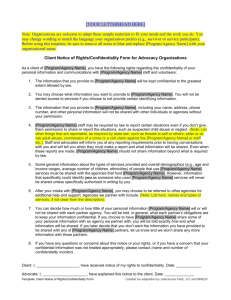slides
advertisement
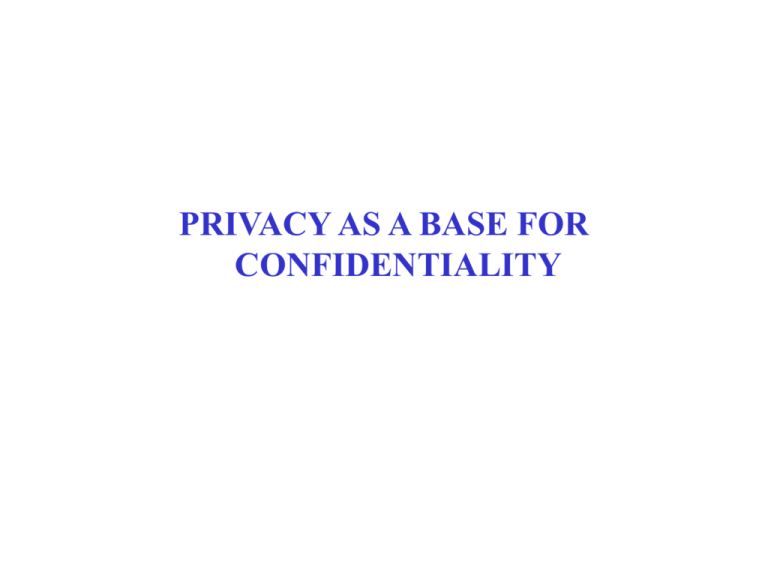
PRIVACY AS A BASE FOR CONFIDENTIALITY WEIS Informational Privacy: The field that study ‘personal (private) information’, including: • Theory: Ontology, Anonymity, Identifiability, Linkability, Confidentiality, etc. • Policy: Languages for specifying privacy preferences and uses for sharing data and methods for enforcing specified terms. • Tools: Anonymous data (information), publishing, browsing, etc. • Legal and ethical aspects (economic?) • Applications: Databases, network, … ---------------------------------------------------------------------------------- • Ontology: What is private information? • Confidentiality: Private Information Confidentiality Atomic private information confidentiality Compound private information confidentiality Non-Private Information Confidentiality Textual private information WEIS My step-daughters continue their work, Vivienne as a nurse in the ICU at the Laun- ceston General Hospital and Angela in public relations for an international firm centred in Bali. Thankfully Angela did not suffer from the recent bombings in a place that had been seen(until the bombings) somewhat paradisiacally in the Indian Ocean, although even Bali has had its traumatic problems in the last few decades as a brief history of the place will reveal. Angela travels for a real estate firm selling time-share apartments. George Price ‘Body’ of private information? Word, Sentence, Paragraph, etc. Who’s private information is this? John’s uncle, Jim, saw Mary’s mother, Susan. What part is the private information of John, Jim, Mary, Susan? WHAT IS PRIVATE INFORMATION? WEIS Current definition: Private information is personal identifying information Our definition: We adopt Linguistic base Private assertions are personal identifying assertions Information is divided into: NON-PRIVATE INFORMATION Zero (privacy) assertion: An assertion that has no referent signifying a single individual. PRIVATE INFORMATION (i) Atomic assertion: An assertion that has a single referent signifying a single individual. (ii) Compound assertion: An assertion that has several referents signifying individuals. Zero (privacy) assertions Spare part ax123 is in store 5. House at 1010 Palm street is burning. Atomic assertions John is a pilot John’s house is burning Compound assertions John and Jim love Mary John, Jim, and Mary hate each other WEIS WEIS Proprietorship: The relationship between individuals and their own atomic private information Any atomic private information of an individual is proprietary private information of its proprietor. Proprietorship vs. possession, ownership, and copyrighting: Non-transferable Two or more individuals are proprietors the same piece of compound private information because it embeds atomic private information from these individuals. But it is not possible that they have identical atomic private information, simply because they have different identities. Proprietary information vs. Nproprietary information • John, Jim, and Mary hate each other ? Atomic assertions • : John and someone hate each other. • : Jim and someone hate each other. • : Mary and someone hate each other. • Someone hates someone • (, , ) + John and Jim love Mary WEIS WEIS • Confidential information is information that is disclosed with an explicit or implicit agreement that it will not be revealed to a third party without the consent of its owner(s). In the context of private information. • Confidential Private Information (or simply CP information) is private information that is released by its proprietor(s), with an explicit or implicit agreement that it will not be revealed to a third party without the consent of its proprietor(s). • CP information can be classified as atomic and compound CP information. WEIS Compound information is proprietary private information of its proprietors. Each proprietor has Right to his/her private information. In the therapist-patient relationship: Confidentiality agreement with any one proprietor that involves compound private information involves other proprietors as implicit participants in the confidentiality agreement, i.e., their consent is required for revealing this information. WEIS • The Tarasoff case (California Supreme Court) • Poddar was an outpatient of a psychiatric hospital. He had depression related to his rejection by Tatiana Tarasoff with whom he had fallen in love. Moore, as Poddar's Psychologist was told by Poddar that he intended to kill Tatiana Tarasoff. Moore informed the campus police. The police detained Poddar but after a short detention released him. Two months later, Poddar killed Miss Tarasoff. WEIS • The court limited the Tarasoff decision to identified victims. Other courts have also specifically required warning victims only when there is “an overt threat of violence toward a specifically identifiable victim.” (Brady v. Hopper, (Moore, 1983)). • Typically, the Tarasoff case is viewed as addressing “the conflict in weighing the patient's right to confidentiality and the need for a trusting psychotherapist-patient relationship in therapy against society's right to be protected from a foreseeable, dangerous, and potentially lethal event.” (Stern, 2003). • In our approach, the case involves the conflict between the patient’s right to confidentiality vs. the third party’s right to his/her private information • • • • • • WEIS-end In analyzing the Tarasoff case, the assertion Poddar intends to kill Tarasoff is clearly a piece of compound private information in Moore’s possession. Since the involved (threat) assertion is compound private information, then it is not solely the proprietary private information of Poddar. It is also proprietary private information of Tarasoff. In its atomic form, the “Tarasoff side” of the compound information can be stated as: Tarasoff is an intended victim of murder or There is a plan to kill Tarasoff. So Moore is no longer dealing with the “private sphere of Poddar” but also with the “private sphere of Tarasoff.” Contrast this with Poddar telling Moore that he intends to kill a dog, or cat or cut a tree where the information is proprietary private information of Poddar. In this case, all clichés of confidentially of a patient can be asserted because it does not embed private information of another individual. Consequently, we claim that compound private information should not necessarily be included in the notion of doctor-patient confidentiality. Furthermore, in the CP information case, the confidentiality agreement extends implicitly to other proprietors. So in the CP information case, the therapists have the duty of confidentiality to their patients and implicitly to the third party as well. They are in possession of personal identifiable information that is also the proprietary information of this third party. Even the disclosure of this (compound) private information (e.g., to patient’s family) requires the consent of this third party as much as it does the patient. • If the patient does not mention in his/her threat an identifiable person, then no compound private information is involved; hence, any person who becomes a victim of the patient can claim no right to private information. Courts have already confirmed this conclusion and cases have been dismissed on the ground that no evidence was there as an explicit threat to an identifiable person (e.g., Leonard v. Latrobe Area Hospital, Pennsylvania; Thompson v. County of Alameda, California; Brady v. Hopper, Colorado – see (Buckner & Firestone, 2000)). • Privacy and Safety • A therapist-patient relationship establishes a duty for “the right to privacy” and not for “the sake of safety of the patient and the public” (Fleming & Maximov, 1974), (Buckner & Firestone, 2000).The California supreme court asserted that confidentiality "ends where the public peril begins". Notice that the therapist in the Tarasoff case did warn the police about the potential danger of Poddar, but did not inform Tarasoff herself. • “Limitation to the privilege of confidentiality, ... [as in] ... lawyers must keep communications from clients privileged, except if such communication pertains to the execution of a future crime.” Typically, disclosure of confidential medical information is based on the utilitarian justification that it is of the public interest where the benefits to society outweigh the patient's interest in keeping the information confidential. • Privacy-based justification for releasing CP information has a deontological base. • Suppose that Poddar told Moore that he intended to set fire to a certain building. This information is not private information of a third party because it does not involve an identifiable individual. The dilemma here concerns confidentiality vs. public safety (consequential) not confidentiality vs. right to private information (deontological). • “Laws inevitably threaten the benefits that flow to consumers and the economy from responsible information-sharing.” According to Cate & Staten, “no privacy law should be enacted unless the harms it addresses are explicitly balanced against the law’s interference with the benefits that flow from information-sharing”. • We claim that no anti-privacy law should be enacted unless the benefits it addresses are explicitly balanced against the law’s interference with the protection of individuals. So Texas Legislature adaptation of health and safety code, which governs disclosure of communication during the course of mental-health treatment, has an unnecessarily wide scope. The statute permits, but does not require, disclosure, if the professional determines that there is a probability of harm to the patient or others. This should be applied to the non-private harm. However, the law should specify that when the harm involves an identifiable individual, then he/she has the right to know about this harm, regardless of confidentiality and professional practices. • This argument with regard to CP information can be used to counter claims that the patients would be deterred by a lack of confidentiality. Also, it gives more options at the social policy level. The patients can be informed in advance what kind of confidential information is DEFINITELY not protected by the confidentiality of a therapist-patient relationship. Private information of a third party should not be part of the so-called “negotiated confidentiality.” Also CP privacy-based justification can be used to argue that the therapist owes no confidentiality duty to a patient and thus there is no foundation to claims of liability in tort and/or a patient’s claim for embarrassment resulting from the disclosure of private information that also belongs to a third party. • Privacy vs. Common Good • According to Etzioni, “rights” leaves no room for compromise (Etzioni, 1999). This characterization is taken as a rationalization to reduce the reliance on right-based justifications. He claimed that concern for privacy rights has obstructed advancing the notion of common good, as in such actions as releasing medical and criminal records and electronic monitoring in certain situations. • We show next that, in our conceptualization of information privacy, the opposite is true: concern for (informational) privacy rights advances the common good as a reason for breaching confidentiality. • Private information has linguistic embodiment in terms of written or spoken assertions. There is a potentially infinite stock of private information about every individual. Others attach some of this information to the individual); some information is generated by the individual him/herself. So a logical step in analyzing the relationship between a proprietor and his/her information is to identify the “source” of this information in preparation of examining any right-based claims.

